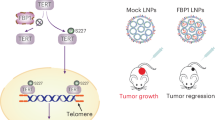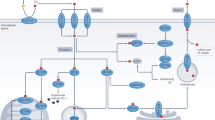Abstract
Increased expression of mac25/insulin-like growth factor binding-protein related protein-1 (IGFBP-rP1) in human breast and prostate epithelial cell lines results in the suppression of tumor growth. CDNA expression array analysis revealed increased manganese superoxide dismutase (SOD-2) expression in the mac25/IGFBP-rP1-transfected M12 human prostate cancer cell line compared to M12 control cells. SOD-2 has been postulated to be a tumor suppressor. SOD-2 was also increased in LNCaP cells stably transfected with mac25/IGFBP-rP1, but not in mac25/IGFBP-rP1-transfected PC-3 cells. Mac25 LNCaP cells had a marked decrease in tumor growth in nude mice compared to controls, but there was no difference in tumor growth in mac25 PC-3 cells compared to control. Phosphorylated Erk and Akt were increased in the M12 and LNCaP transfected mac25/IGFBP-rP1 cells but not PC-3 mac25. Inhibition of PI-3 kinase results in a marked decrease in viability of the M12-mac25 cells compared to M12 controls. Cells treated with H2O2 result in an increase in phospho-ERK. Transfection of SOD-2 in M12 cells markedly decreased tumor growth, apoptosis, G1 delay in the cell cycle, and expression of senescence associated β-galactosidase. These results suggest that one of the downstream mediators of the senescence-associated tumor suppression effect of mac25/IGFBP-rP1 is SOD-2.
This is a preview of subscription content, access via your institution
Access options
Subscribe to this journal
Receive 50 print issues and online access
$259.00 per year
only $5.18 per issue
Buy this article
- Purchase on Springer Link
- Instant access to full article PDF
Prices may be subject to local taxes which are calculated during checkout








Similar content being viewed by others
References
Bae V, Jackson-Cook C, Brothman A, Maygarden S and Ware J . (1994). Int. J. Cancer, 58, 721–729.
Bae V, Jackson-Cook C, Maygarden S, Chen J, Plymate S and Ware J . (1998). Prostate, 34, 275–282.
Bae V, Jackson-Cook C, Maygarden S, Edelman W, Brothman A, Chen J and Ware J . (1995). Proc. Amer. Assoc. Cancer Res., Cancer Res., 642 (abstract), 55.
Baker A, Oberley L and Cohen M . (1997). Prostate, 32, 229–233.
Birkenkamp KV, Dokter WHA, Esselink MT, Jonk LUC, Kruijer W and Vellenga E . (1999). Leukemia, 13, 1037–1045.
Birnbaum R, Ware J and Plymate S . (1994). J. Endocrinol., 141, 535–540.
Bost F, Caron L, Marchetti I, Dani C and Le Marchand-Brustel Y . (2002). J. Biochem., 361, 621–627.
Bostwick D, Alexander E, Singh R, Shan R, Qian J, Santella R, Oberley L, Yan T, Zhong W, Jiang X and Oberley T . (2000). Am. Cancer Soc., 89, 123–134.
Chen Q, Bartholomew J, Campisi J, Acosta M, Reagan J and Ames B . (1998). J. Biochem., 332, 43–50.
de Haan J, Cristiano F, Iannello R, Bladier C, Kelner M and Kola I . (1996). Hum. Mol. Genet., 5, 283–292.
Hawkins V, Doll D, Bumgarner R, Smith T, Abajian C, Hood L and Nelson P . (1999). Nucleic Acids Res., 27(1), 204–208.
Huang C, Zhang Z, Ding Z, Li J, Ye J, Leonard S, Shen H-M, Butterworth L, Lu Y, Costa M, Rojanasakul Y, Castranova V, Vallyathan V and Shi X . (2000). J. Biol. Chem., 275, 32516–32522.
Hwa V, Oh Y and Rosenfeld R . (1998a). Acta. Ped. Scand., 428, 37–45.
Hwa V, Tomasini-Sprenger C, Bermejo A, Rosenfeld R and Plymate S . (1998b). J. Clin. Endocrinol., 83, 4355–4362.
Jackson-Cook C, Bae V, Edelman W, Brothman A and Ware J . (1996). Cancer Genet. Cytogen., 87, 14–23.
Kim K, Rodriguez A, Carrico P and Melendez J . (2001). Antioxidants Redox Signal., 3, 361–373.
Kim H-P, Roe J-H, Chock P and Yim M . (1999). J. Biol. Chem., 274, 37455–37460.
Kinscherf R, Claus R, Wagner M, Gehrke C, Kamencic H, Hou D, Nauen O, Schmiedt W, Kovacs G, Pill J, Metz J and Deigner H . (1998). FASEB J., 12, 461–467.
Li N, Oberley T, Oberley L and Zhong W . (1998a). J. Cellular Physiol., 175, 359–369.
Li N, Oberley T, Oberley L and Zhong W . (1998b). Prostate, 35, 221–223.
Lopez-Bermejo A, Buckway C, Devi G, Hwa V, Plymate S, Oh Y and Rosenfeld R . (2000). Endocrinology, 141, 4072–4080.
McCord J . (2000). Am. J. Med., 108, 652–659.
Oberley L . (2001). Antioxidants Redox Signal., 3, 461–472.
Oberley TD and Oberley LW . (1997). Histol. Histophathol., 12, 525–535.
Oh Y, Nagalla R, Yamanaka Y, Kim H, Wilson E and Rosenfield R . (1996). J. Biol. Chem., 271, 30322–30325.
Plymate S, Ware J, Tennant M, Thrasher J, Chatta K and Birnbaum R . (1996). J. Clin. Endocrinol. Metab, 81, 3709–3716.
Pritchard C, Hsu L, Delrow J and Nelson P . (2001). Proc. Natl. Acad. Sci. USA, 98, 13266–13271.
Rhee S, Bae Y, Lee S-R and Kwon J . (2000). Science's Signal Transduction Knowledge Environment, www.stke.org/cgi/content/full/OC_sigtrans;2000/53/pe1, pp. 1–4.
Sachdeva R, Martin A-M, Heyworth M, Zeigler-Johnson C, Spangler E, Wlker A, Malkowicz S and Rebbeck T . (2001). Am. J. Hum. Genet., 69(4), 261.
Sprenger C, Damon S, Hwa V, Rosenfeld R and Plymate S . (1999). Cancer Res., 59, 2370–2375.
Sprenger C, Vail M, Evans K, Simurdak J and Plymate S . (2002). Oncogene, 21, 140–147.
Wartenberg M, Diedershagen H, Hescheler J and Sauer H . (1999). J. Biol. Chem., 39, 27759–27767.
Widmann C, Gerwins P, Johnson N, Jarpe M and Johnson G . (1998). Mol. Cell. Biol., 18, 2416–2429.
Wilson E, Oh Y, Hwa V and Rosenfeld R . (2001). J. Clin. Endocrinol. Metab., 86, 4504–4511.
Zhong W and Oberley T . (2001). Cancer Res., 61, 7071–7078.
Acknowledgements
The study was supported by the Veterans Affairs Research Service and DOD to SRP and TDO, and NIH DK52683 and PO1-CA 85859 to SRP.
Author information
Authors and Affiliations
Corresponding author
Rights and permissions
About this article
Cite this article
Plymate, S., Haugk, K., Sprenger, C. et al. Increased manganese superoxide dismutase (SOD-2) is part of the mechanism for prostate tumor suppression by Mac25/insulin-like growth factor binding-protein-related protein-1. Oncogene 22, 1024–1034 (2003). https://doi.org/10.1038/sj.onc.1206210
Received:
Revised:
Accepted:
Published:
Issue Date:
DOI: https://doi.org/10.1038/sj.onc.1206210
Keywords
This article is cited by
-
Powerful p-value combination methods to detect incomplete association
Scientific Reports (2021)
-
Characterization of kinase gene expression and splicing profile in prostate cancer with RNA-Seq data
BMC Genomics (2018)
-
Epithelial cell senescence: an adaptive response to pre-carcinogenic stresses?
Cellular and Molecular Life Sciences (2017)
-
Effects of Oral Administration of CrCl3 on the Contents of Ca, Mg, Mn, Fe, Cu, and Zn in the Liver, Kidney, and Heart of Chicken
Biological Trace Element Research (2016)
-
Insulin-like growth factor binding protein-related protein 1 (IGFBPrP1) contributes to liver inflammation and fibrosis via activation of the ERK1/2 pathway
Hepatology International (2015)



